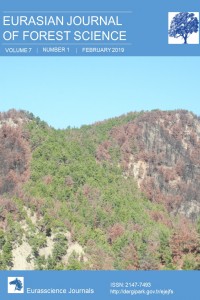Abstract
References
- Fyhrquist, P., Mwasumbi, L., Hæggström, C.-A., Vuorela, H., Hiltunen, R., and Vuorela, P. (2002). Ethnobotanical and antimicrobial investigation on some species of Terminalia and Combretum (Combretaceae) growing in Tanzania. Journal of Ethnopharmacology 79, 169-177.
- Kimaro, A., Isaac, M., and Chamshama, S. (2011). Carbon pools in tree biomass and soils under rotational woodlot systems in Eastern Tanzania. In "Carbon Sequestration Potential of Agroforestry Systems", pp. 129-143. Springer.
- Orwa, C., Mutua, A., Kindt, R., Jamnadass, R., and Simons, A. (2012). Agroforestree database: a tree reference and selection guide version 4.0. Url: http://www. worldagroforestry. org/af/treedb/(Accessed on 15 February, 2011).
- Wagner, H., and Bladt, S. (1996). "Plant drug analysis: a thin layer chromatography atlas," Springer Science & Business Media.
Abstract
Aim of this study to detect organoleptically Acacia seyal fractions (petroleum ether, chloroform, methanol and aqueous) fermented wood"Nikhra" of the fractions accumulating the strongest sweet fragrance these fragrances were mainly accumulated in the petroleum ether
fermented wood "Nikhra" fraction and analysis it by using
chromatographic and spectroscopic analysis. Petroleum ether fermented wood "Nikhra" fraction analysis with TLC and spray TLC with vanillin H2SO4 (pink) (C1, C2,C3,C4,C5,C6,C7), Rf values
(0.92, 0.86, 0.71, 0.64, 0.57, 0.50, 0.36) ,were expected to be phenolic, with vanillin HCL (red) compounds spots (C5,C6,C7) with Rf values (0.57, 0.50, 0.37) was expected to be catechin
and with vanillin H3PO4, blue-violet zones compounds
spots (C6, C7), with
Rf values (0.50, 0.36), were expected to be lignans. Petroleum ether fermented wood"Nikhra" fraction was divided into two types of compounds
classes aromatic and non aromatic by http://research.easybib.com and hence compounds were classified to phenolics and terpenoids compounds by GC/MS. Fragrant
aromatics or terpenoids were targeted in this part of study. GC-MS analysis
gave a spectrum of fragrance aromatic compounds (phenolics) in the petroleum
ether fermented wood "Nikhra" fractions of A.seyal, was Petadecanoic
acid(5.64%) and Tetracosamethyl-cyclododecasiloxane(4.17%) total fragrance
aromatic compounds(44.57%), and main terponoids compounds was Octadecanoic
acid(2.52) % total fragrance aromatic compounds(11.87%).
Keywords
References
- Fyhrquist, P., Mwasumbi, L., Hæggström, C.-A., Vuorela, H., Hiltunen, R., and Vuorela, P. (2002). Ethnobotanical and antimicrobial investigation on some species of Terminalia and Combretum (Combretaceae) growing in Tanzania. Journal of Ethnopharmacology 79, 169-177.
- Kimaro, A., Isaac, M., and Chamshama, S. (2011). Carbon pools in tree biomass and soils under rotational woodlot systems in Eastern Tanzania. In "Carbon Sequestration Potential of Agroforestry Systems", pp. 129-143. Springer.
- Orwa, C., Mutua, A., Kindt, R., Jamnadass, R., and Simons, A. (2012). Agroforestree database: a tree reference and selection guide version 4.0. Url: http://www. worldagroforestry. org/af/treedb/(Accessed on 15 February, 2011).
- Wagner, H., and Bladt, S. (1996). "Plant drug analysis: a thin layer chromatography atlas," Springer Science & Business Media.
Details
| Primary Language | English |
|---|---|
| Journal Section | Articles |
| Authors | |
| Publication Date | February 28, 2019 |
| Submission Date | October 18, 2018 |
| Published in Issue | Year 2019 Volume: 7 Issue: 1 |
Cited By
Sapwood and nikhra heartwood volatiles of two Combretaceae species traditionally used in Sudanese cosmetology and therapy
Journal of Wood Chemistry and Technology
https://doi.org/10.1080/02773813.2024.2393108
E-mail: Hbarist@gmail.com
ISSN: 2147-7493
Eurasian Journal of Forest Science © 2013 is licensed under CC BY 4.0


